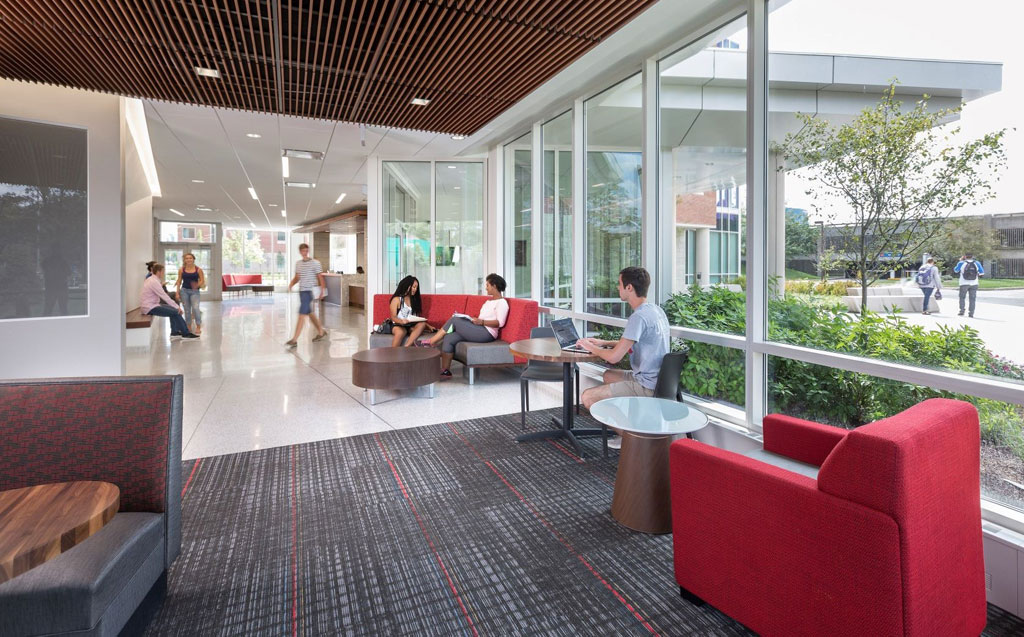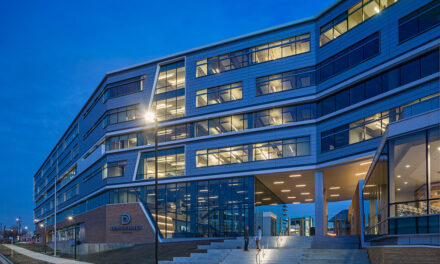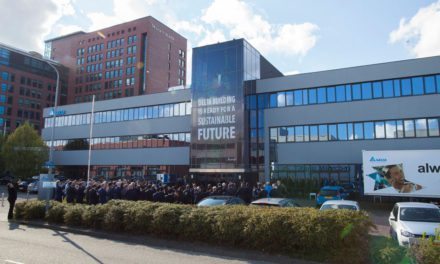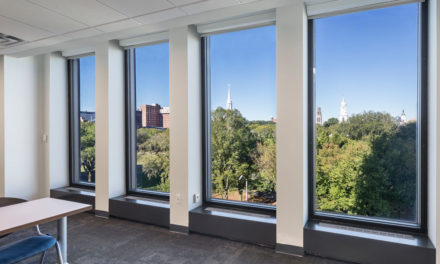(St. Louis, MO, Jan. 17, 2019) One of the elements of safe residence hall design is proper evacuation of the building. When someone enters a building, eventually they will have to exit, sometimes quickly in the case of an emergency. Building codes, emergency strategies and thoughtful design all play important roles in protecting the health, welfare and safety of residence hall occupants when an emergency evacuation is necessary.
According to student housing design expert Javier Esteban, principal at KWK Architects, studies show that in emergency cases, most people tend to try to exit a building in the same way that they entered, but that may not always be the easiest or fastest route to safety.
“As the built environment community learns more and more about how building materials, assemblies and humans behave in cases of emergency, new studies and guidelines are constantly coming into light, along with periodic updates to the codes,” said Esteban. “The safe design of a building is an integrated process that involves many specialists, architects and engineers from multiple disciplines, including fire protection, security design systems, evacuation alarm systems, and structural. All work together toward a common goal of protecting life first and property second.”
The main purpose of building codes is to protect health, safety and welfare as they relate to buildings and their construction, taking into consideration emergency evacuations in cases of fire and smoke. Emergency strategies and codes consider not only human behavior, but also the shape and function of the building, the number of occupants and how different events such as fire, smoke, storms, tornadoes and earthquakes affect different parts of the building.
The study of recent disasters has also helped to shape current building codes, such as the Loma Prieta 1989 earthquake, which helped designers gain a better understanding of how seismic waves behave on different types of soils, and the 2017 Grenfell Tower fire in London where combustible insulation of the exterior cladding contributed to the propagation of a fire that killed 72 people.
Proper evacuation of a building is an important element of safe design. In addition to the required minimum number of exits, minimum corridor and door widths, proper location and safe passageways to these exits, a series of systems are in place to guide the building occupants to a safer place, which is generally, but not always, the exterior of the building. These systems include fire and smoke alarms, fire suppression systems (sprinklers), proper illumination, special illuminated signals visible with smoke in the room/corridor that are connected to backup power or battery, audible alarms and evacuation enunciation devices that guide people to specific places, among many other systems that are common place now in many new residence halls.
“In the last few years, we have gained a better understanding of how smoke behaves in elevator shafts and elevator doors. Smoke evacuation has affected how elevator lobbies are designed. New products have come to market that create smoke curtains in front of elevator doors, providing a smoke separation between the floor and the elevator shaft, and also providing a way for firefighters accessing the floor from the elevator to visually inspect it before proceeding. These devices use a combination of magnets, reinforced plastic motorized curtains, and alarm/smoke detectors in the elevator lobby. They give designers some flexibility to explore multiple options to provide a safe residence hall while also promoting community, in this case eliminating additional elevator lobby enclosures,” said Esteban.
New products and technologies have also been developed to create a safe, community-based corridor within residence halls. Older building codes did not require door closers on bedroom doors facing the corridor in residence halls, said Esteban. When students wanted to interact with each other, but stay in their bedrooms, they just had to open the door. This created a very active corridor that promoted community on the floor but was not always safe in emergencies.
Current codes now require that these communicating corridors also serve as emergency egress corridors; therefore, they must provide a minimum level of smoke and fire protection during a building evacuation, from a half hour up to two or more hours of fire protection.
“One of the key elements is to provide fire rated doors with door closers that provide a positive latching of the door. This safety requirement ensures that bedroom doors are always closed, making the corridor just a passageway,” he said. “To increase the opportunity for communication, students sometimes prop open their doors using a book or heavy object to keep the door from closing, creating a condition that would be very unsafe in the event of a fire.”
There is a device on the market that provides a door closer/holder with a multi-point hold-open function connected to an alarm system that activates the closer in case of an emergency, automatically closing the door. This device is different from the traditional magnetic door closer that only allows for a 90-degree angle.
“The multi-point hold-open function allows the students to create their own ‘door language.’ When the door is fully open, the student is open to visits; when the door is set at 45-degrees, they may be studying, but still open to interaction. Now the corridor is re-gaining its important community activity, but in a safer way,” said Esteban.
About KWK Architects
Founded in 2013 by five architects with a combined 150 years of higher education knowledge and experience, KWK Architects partners with colleges and universities across the United States to create innovative and inspiring places that enhance campus life. Areas of expertise include student housing and dining, and academic and science/technology spaces. KWK Architects has completed more than $1 billion in construction-valued projects since its founding and currently employs a growing staff of 15 at its headquarters in St. Louis, MO. For more information about KWK Architects, visit www.kwkarchitects.com or contact Director of Marketing Cindy Hausler at cindyh@kwkarchitects.com.





